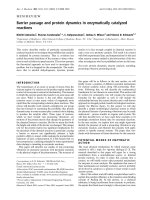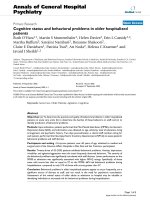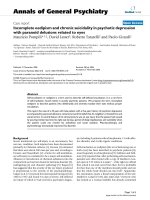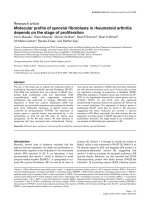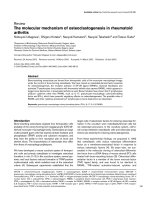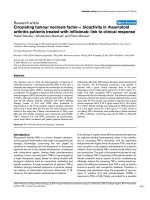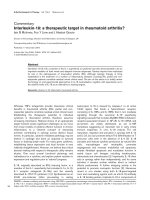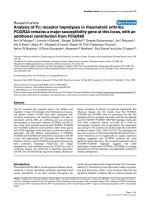Báo cáo y học: "Inflammatory cells and bone loss in rheumatoid arthritis" doc
Bạn đang xem bản rút gọn của tài liệu. Xem và tải ngay bản đầy đủ của tài liệu tại đây (41.06 KB, 3 trang )
Page 1 of 3
(page number not for citation purposes)
Available online />Abstract
Pathogenic bone erosion is often associated with inflammation.
The destructive bone erosion that is often seen in rheumatoid
arthritis is probably due to the close proximity of inflamed tissues to
bone. Over the past decade, major advances have been made in
our understanding of the factors that are crucial in regulating
osteoclast bone resorption. It is not surprising that these factors
are expressed by inflammatory cells that are present in the
rheumatoid joint. It now appears that we can add neutrophils to the
list of inflammatory cells found in the inflamed rheumatoid joint that
express factors that regulate bone erosion.
The report that neutrophils may contribute to regulation of
bone remodelling in rheumatoid arthritis (RA) [1] highlights
the fact that a variety of inflammatory cells are responsible for
the induction of bone loss observed in inflammatory diseases.
Bone erosion and inflammation are not distinctly different
processes, and there is a close relationship between the two.
The fact that similar factors stimulate both processes means
that when inflammation occurs near bone, such as in RA,
local erosion takes place.
The past two decades have witnessed the discovery of several
important soluble factors and cell surface molecules that are
involved in mediating osteoclast differentiation and bone
resorption. Of most importance are receptor activator of nuclear
factor-κB ligand (RANKL) and its receptor RANK. It is
interesting to note that RANK/RANKL interactions were first
described in relation to activities of antigen-presenting cells [2],
and it was the fact that neutrophils may act as antigen-
presenting cells that provided the impetus for the study
conducted by Poubelle and coworkers [1]. In relation to bone
metabolism, RANKL and RANK were initially identified on
osteoblasts and precursor osteoclasts, respectively, and are
crucial for osteoclast formation [3,4]. It is widely accepted that
RANKL, together with macrophage colony-stimulating factor,
are the most important factors that stimulate osteoclast
formation from precursor monocyte/macrophages. The relative
levels of RANKL and osteoprotegerin (OPG), which is the
natural soluble inhibitor of interactions between RANK and
RANKL [3-5], play a vital role in determining whether bone is
formed or lost. Whereas the tumour necrosis factor (TNF)/TNF
receptor ‘like’ molecules RANK, RANKL and OPG are crucial
for physiological osteoclast formation, it is now recognized they
are key regulators of osteoclast activity in disease.
RANKL is present at high levels in RA synovial tissues as
compared with healthy or osteoarthritic synovial tissues [6],
and several inflammatory cell types are probably responsible
for ectopic production of RANKL in synovial tissues adjacent
to bone. In RA synovial tissues, activated lymphocytes
expressing CD3 are a predominant cell type that expresses
RANKL protein [7]. RANKL may also be produced by other
cells of the RA joint, such as synovial fibroblasts [8],
chondrocytes [9], endothelial cells [10] and possibly
activated macrophages [11]. It appears that we can now add
neutrophils to our list of inflammatory cells that secrete
RANKL. Poubelle and coworkers [1] showed that neutrophils
express RANKL on the cell surface, and therefore neutrophil
stimulation of osteoclasts may only have very localized effects
because cell-cell contact is required.
Many inflammatory cytokines that are found in the inflamed RA
joint are known to stimulate osteoclast formation. However,
the ability of interleukin-4 to stimulate RANKL production
reported by Poubelle and coworkers [1] is interesting because
this cytokine is known to inhibit osteoclast formation [12]. In
addition, it was reported by Poubelle and coworkers [1] that
neutrophils in RA synovial fluid also secrete OPG. However,
neutrophil derived OPG may not markedly influence OPG
levels as OPG in RA synovial tissues [13] and synovial fluid
[14] is lower than OA control samples. The reduction in OPG
expression in the rheumatoid joint is also more consistent with
Editorial
Inflammatory cells and bone loss in rheumatoid arthritis
David R Haynes
Discipline of Pathology, School of Medical Sciences, University of Adelaide, North Terrace, SA 5005, Australia
Corresponding author: David R Haynes,
Published: 22 June 2007 Arthritis Research & Therapy 2007, 9:104 (doi:10.1186/ar2213)
This article is online at />© 2007 BioMed Central Ltd
See related research article by Poubelle et al., />OPG = osteoprotegerin; RA = rheumatoid arthritis; RANK = receptor activator of nuclear factor-κB; RANKL = receptor activator of nuclear factor-
κB ligand; TNF = tumour necrosis factor.
Page 2 of 3
(page number not for citation purposes)
Arthritis Research & Therapy Vol 9 No 3 Haynes
increased ratios of RANKL to OPG and bone resorption
observed in active RA [15].
The expression of RANK on the surface of neutrophils may be
related to the reported antigen-presenting activities of neutro-
phils. In addition, expression of TNF receptor-associated factor-
6 by these cells suggests that cells can be activated through
the RANK/RANKL pathway, possibly in an autocrine manner.
With the extensive immunohistological studies conducted in
RA synovial tissues, it seems surprising that RANK, RANKL,
or OPG expression by neutrophils has not previously been
reported. However, when one carefully examines the tissues
used, there are very few neutrophils to be seen. These
tissues have the hallmarks of chronic inflammation,
containing many macrophages, lymphocytes and fibroblasts.
The influx of neutrophils associated with active RA was not
seen in the synovial tissues of these patients, but it might
have been present in the synovial fluid. Importantly, RANKL
expression by activated neutrophils is likely to induce the
rapid bone erosion that occurs in septic arthritis [16].
Neutrophils are also thought to play a key role in the
degeneration of articular cartilage that takes place in septic
arthritis, and it could be speculated that RANKL derived from
neutrophils may in some way be involved. However,
neutrophils are unlikely to have a direct effect through
release of RANKL because although RANK is expressed by
chondrocytes, RANKL has been reported not to activate
human articular chondrocytes [9].
The simple view that neutrophils are leucocytes that are
exclusively involved in acute inflammatory responses and act
as the first line of defence against invading pathogens needs
modification. The neutrophil presence in a number of chronic
inflammatory diseases, such as RA, indicates that these cells
may play an important role in chronic inflammation. It is
increasingly apparent neutrophils exhibit many of the
properties of their fellow phagocytic cells of the monocyte/
macrophage lineage. Their rapid secretion of many factors
that are also released by macrophages, lymphocytes and
fibroblasts indicates that they can play similar roles in chronic
inflammation. Many of these factors are pivotal in causing
tissue destruction, either directly or indirectly.
We are still to determine the importance of the neutrophil in
regulating the bone destruction that occurs in RA and other
chronic inflammatory conditions. However, when inflam-
mation flares take place in RA, large numbers of activated
neutrophils are rapidly recruited to the joint and aggregate
in the synovial fluid. The rapid release of factors that
regulate bone metabolism, such as RANK, by these cells
could provide a large, transient increase in RANKL levels in
the joint, supplementing that normally provided by the
chronic inflammatory cells in synovial tissues. This may
result in rapid stimulation of bone erosion during disease
flares in active RA.
Competing interests
The author declares that they have no competing interests.
Acknowledgements
This work was supported in part by the National Health and Medical
Research Council of Australia. The author wishes to acknowledge the
help of Christopher Holding in the preparation of this manuscript.
References
1. Poubelle PE, Chakravarti A, Fernandes MJ, Doiron K, Marceau AA:
Differential expression of RANK/RANK-L/OPG by synovial
fluid neutrophils from patients with rheumatoid arthritis and
normal human blood neutrophils. Arthritis Res Ther 2007, 9:
R25.
2. Wong BR, Josien R, Lee SY, Sauter B, Li H-L, Steinman RM, Choi
Y: TRANCE (tumor necrosis factor [TNF]-related activation-
induced cytokine), a new TNF family member predominantly
expressed in T cells, is a dendritic cell-specific survival factor.
J Exp Med 1997, 186:2075-2080.
3. Yasuda H, Shima N, Nakagawa N, Yamaguchi K, Kinosaki M,
Mochizuki S-I, Tomoyasu A, Yano K, Goto M, Murakami A, et al.:
Osteoclast differentiation factor is a ligand for osteoprote-
gerin/osteoclast inhibitory factor and is identical to TRANCE/
RANKL. Proc Natl Acad Sci USA 1998, 95:3597-3602.
4. Lacey DL, Timms E, Tan H-L, Kelley MJ, Dunstan CR, Burgess T,
Elliot R, Colombero A, Elliot G, Scully S, et al.: Osteoprotegerin
ligand is a cytokine that regulates osteoclast differentiation
and activation. Cell 1998, 93:165-176.
5. Yasuda H, Shima N, Nakagawa N, Mochizuki S-I, Yano K, Fujise
N, Sato Y, Goto M, Yamaguchi K, Kuriyama M, et al.: Identity of
osteoclastogenesis inhibitory factor (OCIF) and osteoprote-
gerin (OPG): a mechanism by which OPG/OCIF inhibits
osteoclastogenesis in vitro. Endocrinology 1998, 139:1329-
1337.
6. Gravallese EM, Manning C, Tsay A, Naito A, Pan C, Amento E,
Goldring S: Synovial tissue in rheumatoid arthritis is a source
of osteoclast differentiation factor. Arthritis Rheum 2000, 43:
250-258.
7. Horwood NJ, Kartsogiannis V, Quinn JM, Romas E, Martin TJ,
Gillespie MT: Activated T lymphocytes support osteoclast for-
mation in vitro. Biochem Biophys Res Commun 1999, 265:144-
150.
8. Shigeyama Y, Pap T, Kunzler P, Simmen BR, Gay RE, Gay S:
Expression of osteoclast differentiation factor in rheumatoid
arthritis. Arthritis Rheum 2000, 43:2523-2530.
9. Komuro H, Olee T, Kuhn K, Quach J, Brinson DC, Shikhman A,
Valbracht J, Creighton-Achermann L, Lotz M: The osteoprote-
gerin/receptor activator of nuclear factor kappaB/receptor
activator of nuclear factor kappaB ligand system in cartilage.
Arthritis Rheum 2001, 44:2768-2776.
10. Collin-Osdoby P, Rothe L, Anderson F, Nelson M, Maloney W,
Osdoby P: Receptor activator of NF-
κκ
B and osteoprotegerin
expression by human microvascular endothelial cells, regula-
tion by inflammatory cytokines, and role in human osteoclas-
togenesis. J Biol Chem 2001, 276:20659-20672.
11. Crotti TN, Smith MD, Weedon H, Ahern MJ, Findlay DM, Kraan M,
Tak PP, Haynes DR: Receptor activator NF
κκ
B ligand (RANKL)
expression in synovial tissue from rheumatoid arthritis,
spondyloarthropathy, osteoarthritis and normal patients:
semi-quantitative and quantitative analysis. Ann Rheum Dis
2002, 61:1047-1054.
12. Bendixen AC, Shevde NK, Dienger KM, Willson TM, Funk CD,
Pike JW: IL-4 inhibits osteoclast formation through a direct
action on osteoclast precursors via peroxisome proliferator-
activated receptor gamma 1. Proc Natl Acad Sci USA 2001,
98:2443-2448.
13. Haynes DR, Barg E, Crotti TN, Weedon H, Atkins GJ, Zannettino
A, Ahern MJ, Coleman M, Roberts-Thomson PJ, Kraan MC, et al.:
Osteoprotegerin (OPG) expression in synovial tissue from
patients with rheumatoid arthritis, spondyloarthropathies,
osteoarthritis and normal controls. Rheumatol 2003, 43:1-12.
14. Skoumal M, Kolarz G, Haberhauer G, Woloszczuk W, Hawa G,
Klingler A: Osteoprotegerin and the receptor activator of NF-
kappa B ligand in the serum and synovial fluid. A comparison
of patients with longstanding rheumatoid arthritis and osteo-
arthritis. Rheumatol Int 2005, 26:63-69.
15. Haynes DR, Crotti TN, Loric M, Bain GI, Atkins GJ, Findlay DM:
Osteoprotegerin and receptor activator of nuclear factor
kappaB ligand (RANKL) regulate osteoclast formation by cells
in the human rheumatoid arthritic joint. Rheumatology (Oxford)
2001, 40:623-630.
16. Sakurai A, Okahashi N, Nakagawa I, Kawabata S, Amano A,
Ooshima T, Hamada S: Streptococcus pyogenes infection
induces septic arthritis with increased production of the
receptor activator of the NF-kappaB ligand. Infect Immun
2003, 71:6019-6026.
Available online />Page 3 of 3
(page number not for citation purposes)
